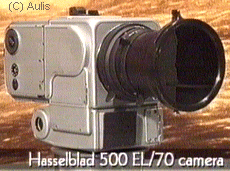
Hasselblad were the manufacturer of the camera that took all of the photos on the Apollo missions. Jan Lundberg was the Manager Of Space Projects at Hasselblad from 1966 to 1975 and responsible for the production and building of the Hasselblad 500 EL/70 cameras that were used on the Apollo Missions. He says 'Originally NASA made all the alterations themselves, then they presented what they had done to us and asked if we could do the same, to which we replied yes we can, and we can do it better. We proceeded to make the alterations that were accepted by NASA.' Protective plates were added to the case and film magazine.
H. J. P. Arnold is an astronomer and keen photographer, an expert on space and astrophotography and was the assistant to the Managing Director at Kodak during the Apollo years. He has authored many space photography books. He comments that the film that was supplied by Kodak for the missions was essentially the same as used here on Earth. it was ektachrome 64 ASA or ISO as it is called today. He has commented that you would expect to see some small dots on the films where a high velocity nuclear particle had hit the film, however no evidence of this whatsoever has come forward. The only thing that would protect the film from this damage would be a thick layer of lead around the camera casing, which according to Hasselblad was not used. Let's also remember that the films were changed whilst outside on the Moon's surface and not in a controlled environment.
An important factor to take into consideration is the great variations in temperature that the film would have had to endure whilst on the lunar surface. The temperature during the Apollo missions were recorded as being between -180F in the shade to an incredible +200F in full Sunshine. How could the film emulsion have withstood such temperature differences? The astronauts can be seen to move between the shadows of the rocks and then into full sunlight in some shots. Surely the film would have perished under such conditions?
人家为什么会问这个问题呢?因为Hasselblad生产的Hasselblad 500 EL/70 型照相机跟地球上的所有照相机一样,Hasselblad设计和生产Hasselblad 500 EL/70 型照相机的时候没有特别考虑日光下的降温问题。
还有,你能看见镜头是黑的吗?